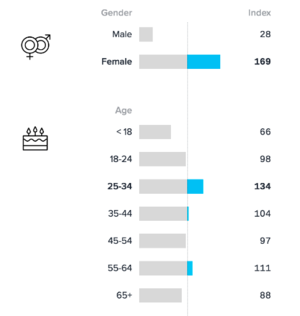3 Customer Personas to Build Into Your Food Brand's Marketing Plan
As we build out our shoppable, contextual advertising products for CPG brands, our team has essentially had to take a crash course in how online marketing fits into what we do: food tech, digital grocery, and shoppable recipe content for publishers. Clearly, there's a holy grail for CPG food brands, but by only focusing on this one type of cook/shopper could alienate huge numbers of people in more "niche" markets. So, we dove into our network demographic data and collected some anecdotal evidence in order to provide some new customer personas you may have overlooked. Consider these groups as markets for your next campaign.
Empty Nesters
Who: Yes, women aged 25 to 34 are our biggest recipe-browsing demographic group. But that's followed closely by women, ages 55 to 64.
What: This group, in proportion to others, buys more beverages (non-alcoholic), soups and canned foods, and frozen products.
Why: As part of the baby boom generation, women ages 55 to 64 likely feel more comfortable cooking back-of-the-box recipes in their crockpot than millennials, who value fresh produce and learning new kitchen techniques. They also love sipping lemonade with pals or creating impressive dishes with pre-made products (think a tube of biscuit dough or pre-grated Mexican cheese blend).
How: Reach this group by appealing to the fresh start they're likely experiencing as their children leave the home for college and adult life. They're looking for simple recipes for entertaining or ways to use their favorite brands in clever ways but with relatively familiar flavors.
Asian-American Families
Who: Middle-aged Asian consumers generally lay low in our network, but when looking at a few food categories, they surge as a primary demographic group. In these cases, the rate of "No Kids" to "Has Kids" shifts to favor of "Has Kids."
What: Soup and canned foods!
Why: In looking at the various Asian recipes (from a variety of cuisines--Thai, Filipino, Korean, Indian) that our readers love, one thing becomes very clear: finding many traditional Asian ingredients in Western grocery stores can be a challenge.
As a result, Asian American families purchase a lot of canned goods that they might be able to find fresh in the dish's country of origin, like coconut milk or bamboo shoots. Similarly, in many Asian American communities, some canned foods have been adopted as part of the cuisine, like ketchup or SPAM.
How: Asian American communities are fast-growing but notoriously underserved. Sometimes creative solutions are in order, like Samosa Digital Network did a few years ago, launching a firm to target South Asians when the capabilities didn't exist at other agencies.
Moms with Lower Incomes
Who: There's a very clear market at the intersection of a few demographic groups. When income decreases, gender tips to being overwhelmingly female and the percentage of people with children also increases by 7%, in our network.
What: The most popular types of recipes for parents with lower incomes are, unsurprisingly, those recipes classified as "Quick and Easy."
Why: While we don't have the exact data to back it up, this combination of factors (overwhelmingly female, much lower income than our network average) leads us to believe that there is likely only one income in these homes. For single moms, making dinner nutritious and cost-effective while juggling a full-time job and school schedules is practically impossible.
How: We began this article by noting that moms are always targeted by food marketing campaigns, but often the content is incredibly nostalgic or aspirational. There's something to be said for content that keeps it real and represents what the life of a mom is really like.




